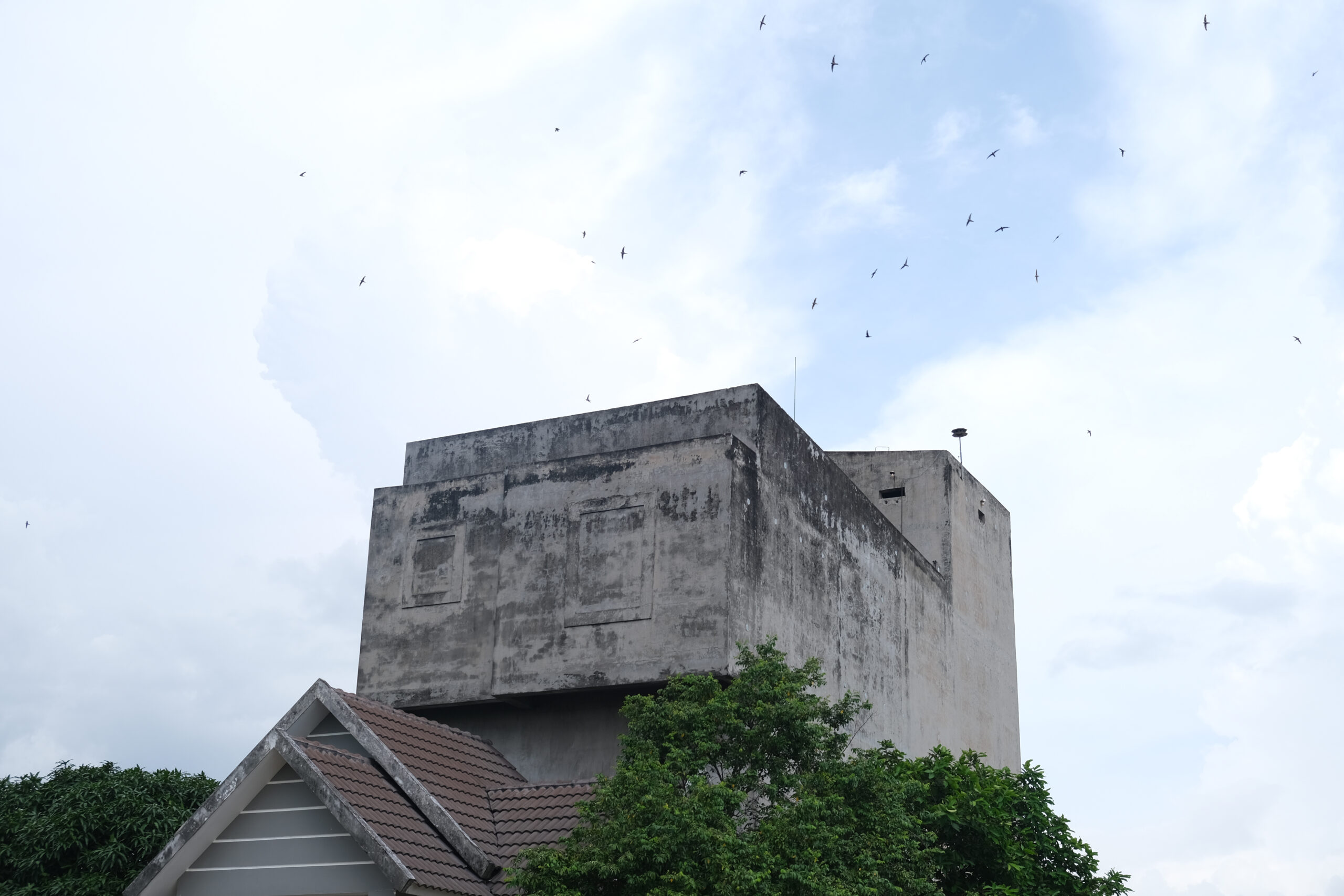Where the birds might still come
Sound – research- based

Where the bird might still come is a sound – research-based project draws from the concept of “architecture of waiting”, inspired by the swiftlet houses of Southern Vietnam.
In the wild, swiftlets are cave dwelling birds that traditionally nest along the coastal cliffs. However, in recent decades, due to the impact of climate change, environmental degradation, and the rise of swiftlet farming technologies, these birds have increasingly migrated inland.
In Vietnam, swiftlet houses are hybrid concrete structures that merge the vernacular of industrial and residential architecture. They are built to simulate the natural living conditions of swiftlets in caves, using artificial bird calls to lure wild birds into nesting inside. These structures not only serve the exploitation of swiftlet nests as “white gold” – that the nests can be “mined” and that the create a reciprocal economy, but also it used to act as a legal loophole strategy: local people transform agricultural land into construction land by erecting these “bird-calling architectures” as a facade. As a form of ecological extraction, it reflects how capitalist ecology demands intersect with local informal economies, often causing harm to land, noise pollution. Yet, it is also a “passive” structure: it does not domesticate the birds, merely emits simulated calls – and waits. Within this act of waiting lies a form of hope, or perhaps a reflection of a new ecological manipulation.
The project explores how these “architecture of waiting” emerge in areas where rapid urbanization and environmental instability continuously reshape the landscape. They are filled with potential, tension, and symbolic meaning. It raises complex questions about the possibility of coexistence, the tension between care and dispossession, and the interplay between nature, capitalism, and development policies. How can the reconstruction of new settlements for swiftlets be truly about a form of reciprocal coexistence rooted in the logic of bioeconomy—or is it merely another manifestation of a new capitalist growth model?
The concept of “architecture of waiting” is not a universal or fixed term in philosophy or architecture, but it has been used in various artistic, philosophical, and social theory contexts to refer to spaces, structures, or existential states in which subjects are “suspended” in an in-between condition—a zone awaiting approval, a stalled project, or a half-finished urban development. These places evoke a sense of stretched, indefinite time. They also reflect existential states in which people are caught between moments or purposes. The state of “waiting” may seem temporary, but it can stretch on indefinitely. Within that waiting, there always exists the simultaneous possibility of both hope and disappointment.
The architecture of waiting can also be understood as a threshold space—a neutral zone, a state of “inter-being.” It may refer to transitional spaces where people don’t linger for long, merely passing through. These spaces often feel empty yet bear traces of presence; familiar yet belonging nowhere, with time suspended—lacking a clear past and no defined future.
Waiting spaces can also be seen as a kind of heterotopia, in Michel Foucault’s sense of the term—both real and symbolic, existing as a reflection or distortion of social reality.
Characteristics of heterotopias according to Foucault include:
They appear in every culture, but in different forms.
Their function can change over time.
They are separate from ordinary spaces, yet still connected to them.
They accumulate multiple layers of time, or are cut off from time altogether.
They can reflect or invert real spaces, creating a kind of “counter-society.”
In rapidly urbanizing regions like Vietnam, these in-between spaces become increasingly visible in informal constructions, suspended projects, half-realized or frozen urban plans, and abandoned residential areas—exposing the fragmented pace of development and the instability of social structures.
Amidst these semi-urban zones, the architecture of “swiftlet houses” or “nest farms” emerges as a symbol of a new economic movement—a breakthrough in animal husbandry techniques, promising high returns and painting a vision of a new future.
In the swiftlet farming industry, the success of a swiftlet house depends on numerous factors: a prime location, an ideal spatial setup, and advanced systems that simulate environmental conditions are all necessary. However, the key determinant of success or failure lies in whether the swiftlets can be lured to nest. In this sense, sound becomes the most crucial element.
Likewise, within the conceptual orientation of “the architecture of waiting,” this project centers sound as both a focal point and an intermediary bridge—a threshold space between The Call and the Wait. One is an active gesture, the other a passive state—yet both are acts oriented in the same direction: reaching beyond the present, toward something not yet arrived. And in between them lies a temporal dislocation.
It is precisely in this in-between space that sound becomes a measure of a sonic terrain—of decay, delay, and the suspension of longing. Is the call ever answered, or is it swallowed into the vast unknown? Is the echo a reply, or merely the sound of itself returning? And if there is a response, is it truly what we had hoped for?
Here, sound is not merely a signal, but a form of incomplete presence. This intermediary space holds latent possibilities—where resolution is always deferred, and the identity of the subject remains in flux.
The project raises the question: Can a wounded land still attract life? Where the birds might still come? Can a once-forgotten place become a space for multispecies coexistence, or at least a place to listen and hope? Like the Vietnamese proverb “Đất lành chim đậu” (Good land, birds rest), this work becomes an inviting act of contemplation – a small ritual oriented towards buen vivir.
This phenomenon sits at the intersection of urbanization, bioeconomy, climate change, migration, and local survival strategies. These bird-calling structures are both traces of exploitation and fragile symbols of survival and waiting.